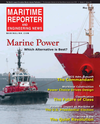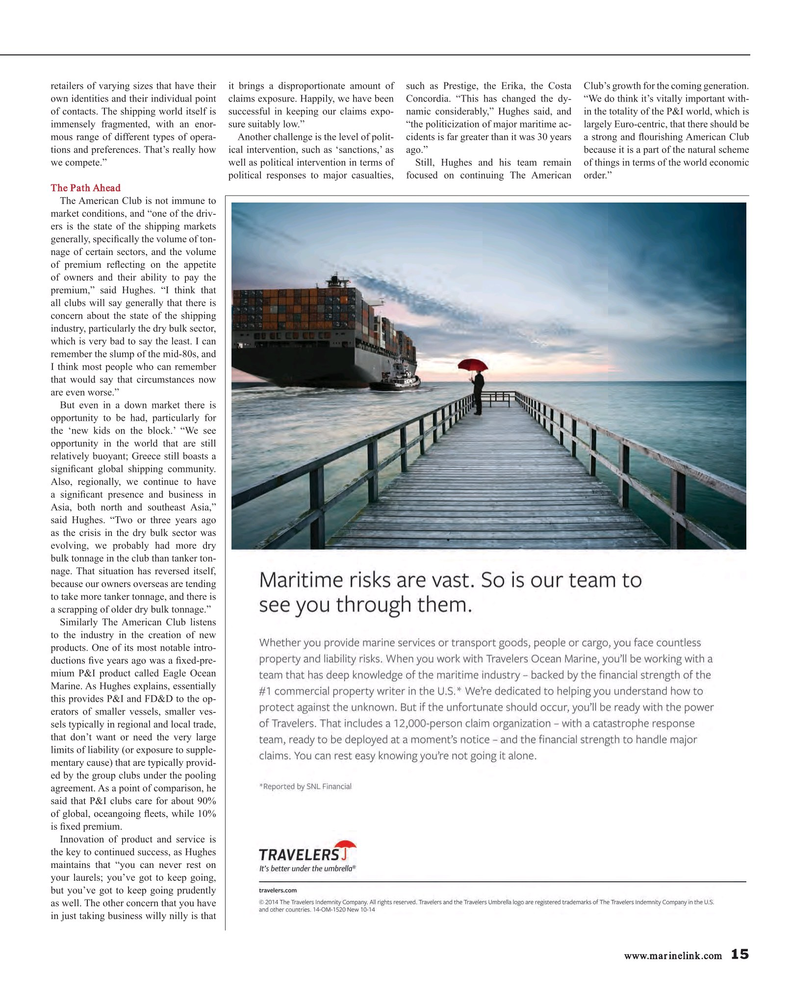
Page 15: of Maritime Reporter Magazine (May 2016)
The Marine Propulsion Edition
Read this page in Pdf, Flash or Html5 edition of May 2016 Maritime Reporter Magazine
retailers of varying sizes that have their it brings a disproportionate amount of such as Prestige, the Erika, the Costa Club’s growth for the coming generation. own identities and their individual point claims exposure. Happily, we have been Concordia. “This has changed the dy- “We do think it’s vitally important with- of contacts. The shipping world itself is successful in keeping our claims expo- namic considerably,” Hughes said, and in the totality of the P&I world, which is immensely fragmented, with an enor- sure suitably low.” “the politicization of major maritime ac- largely Euro-centric, that there should be mous range of different types of opera- Another challenge is the level of polit- cidents is far greater than it was 30 years a strong and ? ourishing American Club tions and preferences. That’s really how ical intervention, such as ‘sanctions,’ as ago.” because it is a part of the natural scheme we compete.” well as political intervention in terms of Still, Hughes and his team remain of things in terms of the world economic political responses to major casualties, focused on continuing The American order.”
The Path Ahead
The American Club is not immune to market conditions, and “one of the driv- ers is the state of the shipping markets generally, speci? cally the volume of ton- nage of certain sectors, and the volume of premium re? ecting on the appetite of owners and their ability to pay the premium,” said Hughes. “I think that all clubs will say generally that there is concern about the state of the shipping industry, particularly the dry bulk sector, which is very bad to say the least. I can remember the slump of the mid-80s, and
I think most people who can remember that would say that circumstances now are even worse.”
But even in a down market there is opportunity to be had, particularly for the ‘new kids on the block.’ “We see opportunity in the world that are still relatively buoyant; Greece still boasts a signi? cant global shipping community.
Also, regionally, we continue to have a signi? cant presence and business in
Asia, both north and southeast Asia,” said Hughes. “Two or three years ago as the crisis in the dry bulk sector was evolving, we probably had more dry bulk tonnage in the club than tanker ton- nage. That situation has reversed itself, because our owners overseas are tending to take more tanker tonnage, and there is a scrapping of older dry bulk tonnage.”
Similarly The American Club listens to the industry in the creation of new products. One of its most notable intro- ductions ? ve years ago was a ? xed-pre- mium P&I product called Eagle Ocean
Marine. As Hughes explains, essentially this provides P&I and FD&D to the op- erators of smaller vessels, smaller ves- sels typically in regional and local trade, that don’t want or need the very large limits of liability (or exposure to supple- mentary cause) that are typically provid- ed by the group clubs under the pooling agreement. As a point of comparison, he said that P&I clubs care for about 90% of global, oceangoing ? eets, while 10% is ? xed premium.
Innovation of product and service is the key to continued success, as Hughes maintains that “you can never rest on your laurels; you’ve got to keep going, but you’ve got to keep going prudently as well. The other concern that you have in just taking business willy nilly is that www.marinelink.com 15
MR #5 (10-17).indd 15 5/2/2016 12:27:46 PM

 14
14

 16
16
